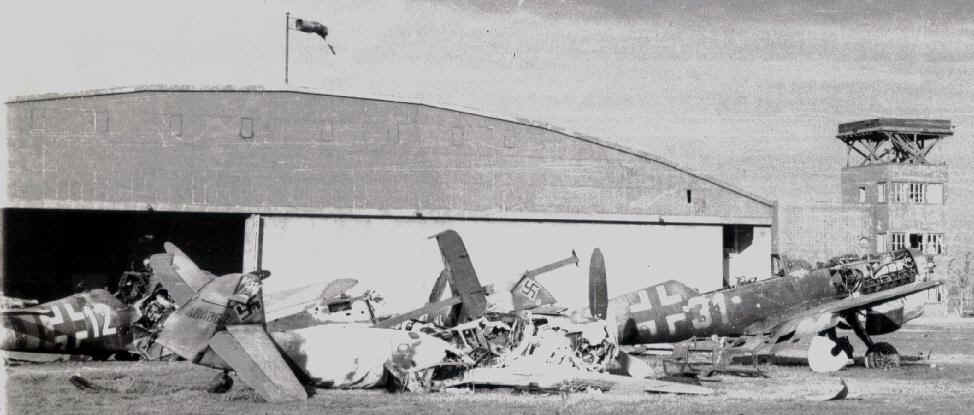
Image du Jours -- World War II
About this Hangar Scene -- WWII #11 of 23.

(Image from Stockum-Cashion Collection)
There are at least three hangars in a row on this very large base. Judging from the windsock and smoke, the wind is moving along at a pretty good clip -- maybe 15 to 20 mph. There is enough sun to determine sun angle and if we chose a series of towns where these aircraft were known to be, we might be able to determine which way the hangars faced and consequently, the latitude of the bases -- again, assuming a spring/early summer time frame. This is easier to do here than places near the equator as New Guinea was.
(When these images were originally posted, I had no idea of the actual location but now, more adept historians have agreed that the location must be Köthen, 80 miles SW of Berlin.)
We will continue to address the Me-109.
In today's photo, to the far left is Me-109G with white "12" (common in late-1944 and 1945) and colored band on the fuselage. It has a hellaious tear in the fuselage side which had to have been done on the ground since I doubt it could have been airborne in that condition. I believe this aircraft might have been destroyed with an explosive charge. There is the outward tear adjacent to the floor of the cockpit.
I think I can detect the same tone on its wing tips as the band on the fuselage -- this might be the dark yellow fuselage band and wing tips of all Luftwaffe aircraft assigned to the Eastern Front -- where this aircraft isn't. The Eastern Front had collapsed in late-ish 1944 and those aircraft that could fly had "gone West" to be reassigned elsewhere in Germany.
In a book by Martin Caidin, is a photo of a "12" which has exactly the same markings as this one but the caption just says something nondescript, like "Me-109" -- big deal! Anyone would know that!
(See what expert captions you are receiving with "your" photos? One time, I gave Holy-Hell to a Time-Life editorial staff for their poor captions in a new series of books on WWII. I named a few pages and images and told them what should have been there. Later, they responded by basically offering me a job -- they volunteered that they "could not" send any photos to me for captioning but rather asked if I would consider moving to NYC. But I digress –)
Next to "12" is an Me-109G-10 with tail number 464862. This airframe was burned in place and it was most likely on its landing gear when burned since the prop is not damaged -- it just settled slowly to the ground. Also, the canopy was off when it burned and is resting beside fuselage.
At ninety degrees to Me-109 is a Stuka 87. It could be an A, B, or D model -- too hard to tell from this or other photos in the collection.
Still on its landing gear is an Me-109G1/G12 with a "31" on the fuselage. Its spinner is beside it and the lower engine door is hanging loose by its hinge -- this lets the oil cooler swing down for access to the underside of the engine -- which is the top side since the engine is inverted by our thinking.
This aircraft is rather unique because its canopy is resting beside it and it is a tandem cockpit. The bulge in the canopy for the backseat pilot can be seen in the photo. Some models retain the two cowling guns for practice but this one does not seem to have them. Perhaps it never did, or they had been removed locally. Toward the end of the war, the several that were built, were retrofitted with other guns and shoved into combat. This is a rare aircraft for few were made, yet it is not the only tandem "fighter" on the field.
The control tower looks pretty bad but I see no strafing strikes on it, nor do I see evidence of bomb or artillery damage anywhere. The crude flat addition to the top of the control tower was a Flak gun station.
One wonders how much thought was given to which aircraft might be serviceable when they were destroyed or was it as simple as which aircraft they could set a fire?
Incidentally, the leading ace of WWII, Erich Hartmann downed 352 aircraft; Gerhard Barkhorn downed 301; Gunther Rall had 275; Heinrich Bar had 220; and Hans Marseille had 158. This is a total of 1,306 aircraft -- and these five pilots always insisted on flying the Me-109 in combat.
Ken Cashion